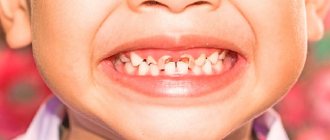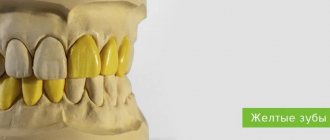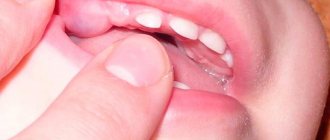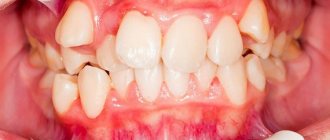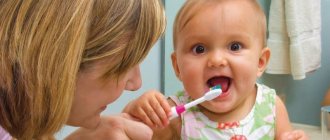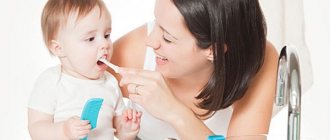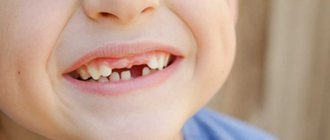The first signs of yellow teeth may appear in a child with the appearance of the first molar. At this stage, parents should be careful and seek advice from a pediatric dentist. If you exclude all factors that influence the darkening of tooth enamel, then it is quite possible that you will be able to correct the natural tone of the tooth enamel of growing teeth. These are the factors.
- Insufficient oral hygiene. If you don't supervise your baby and brush twice a day daily, plaque buildup can negatively impact the shade and formation of your baby's yellow molars.
- Correction of baby food. If a child consumes large quantities of coloring juices (carrots, pomegranates, cherries), pigment may be deposited on the hard tissue of the teeth. If the tint does not disappear within a day, then it is better to exclude such “natural” juices from your baby’s diet. The consumption of sweet and flour products is also important. It is sometimes difficult for a child to refuse sweets, but consuming sweets too often can directly affect the color of tooth enamel. Carbohydrates are a breeding ground for pathogenic bacteria, which produce acids during their life. It is these acids that destroy tooth enamel.
- Taking tetracycline antibacterial drugs. Certain medications can affect the color of enamel. This applies to both the use of medications by the baby himself and the use of medications by the mother during pregnancy. If the first signs of darkening appear during treatment of a child, you should consult a doctor and, possibly, replace the drug with another group of antibiotics.
- Enamel hypoplasia. Only the thin coating of the crown—tooth enamel—has a milky white color. Beneath it are darker tooth tissues - the so-called dentin. It is the translucency of dentin that causes the yellowish or bluish tint. If the enamel layer is insufficient, which sometimes happens in children as a pathology, then the dentin shows through quite strongly, and the teeth acquire a dirty yellow tint. It is not always possible to eliminate this fact. The dentist may prescribe an additional calcium supplement for your baby to support the development of tooth enamel. However, this is not a radical measure, so it is worth waiting until the child’s dentition is fully formed and then choosing a correction method.
- Poor quality drinking water. Large amounts of iron in water can cause yellowing of the enamel. If this situation occurs among all residents of a given region, then special purification filters for drinking water should be purchased. Otherwise, your child will have to put up with yellow teeth.
- Changes in enamel color while wearing braces. Correcting a child’s bite is a necessary and very important event. However, enhanced hygiene should be especially carefully monitored during this period. Plaque forms in the places where the braces are attached, which cannot be cleaned with a regular toothbrush and can form a yellow stain on a child’s tooth. This can lead to darkening of the enamel or even the development of dental caries. You can cope with this problem using a special irrigator designed for cleaning teeth in hard-to-reach places. Or you can visit a dentist and have your mouth professionally cleaned.
- In rare cases, yellowing of teeth can be a consequence of a general illness in the child's body. Diagnoses such as hepatitis, fluorosis, kidney disease, and serious metabolic disorders can provoke changes in the structure of the hard tissues of the teeth. In this case, the question is more about treating the root cause than its consequences.
Is yellowness normal or pathological?
Not every yellowness should be perceived as a deviation from the norm. Sometimes, due to hereditary factors, a child’s enamel becomes more transparent than that of other children. The lack of white pigment causes the dentin to show through, resulting in darker teeth.
Some dentists are inclined to believe that it is better not to correct or whiten such enamel. At least until the child reaches adulthood and hard tissues are fully formed.
If yellow teeth are showing signs of health, the best thing you can do for your baby is to practice good oral hygiene and good nutrition.
My child’s teeth have turned yellow – what should I do?
Very often, pediatric dentists hear from parents that their child’s teeth have turned yellow . Of course, this makes you worry and directs you to search for useful information on the Internet and books. For what reasons does this problem occur and is it possible to somehow fix it?
Insufficient dental care is the first reason why a child’s teeth turn yellow
One of the main reasons for the appearance of yellow plaque is the consumption of tea and other drinks that can stain the teeth. Good, proper oral hygiene will help to cope with this problem. It is advisable while the child is small that his parents brush his teeth, and for older children who brush themselves, this procedure is monitored. Poor dental care can cause yellow stains on your teeth. Particular attention should be paid if the child has orthodontic structures in his mouth. As a rule, their presence prevents you from cleaning your teeth well, so it is recommended to periodically have them cleaned by a dentist.
The child's teeth have turned yellow due to thinning tooth enamel
The next reason why a child's teeth turn yellow is thinning of the tooth enamel or its chips. Enamel is the membrane that covers the tooth. In addition to its protective properties, it also gives whiteness to both children’s and adult teeth. Beneath it is dentin, which by its nature has a yellowish tint. Depending on many reasons (for example, drinking carbonated drinks), it becomes thinner, and dentin begins to show through the enamel. As a preventive measure, it is worth limiting the consumption of carbonated drinks and brushing your teeth carefully with a soft toothbrush.
Medicines are the third reason why a child’s teeth turn yellow
Taking various medications can also negatively affect the color of teeth. For example, antibacterial drugs can give a yellow tint to teeth not only after being taken directly by the child, but also if the mother took such medications while pregnant. In addition, scientists have established a relationship between the mother’s teeth during pregnancy and the condition of the child’s teeth. Therefore, during pregnancy, a woman can take some measures to avoid problems with her own child’s dental health in the future. Firstly, try not to take antibiotics without acute indications. Secondly, take enough vitamin C (thanks to it, tooth enamel becomes strong). Thirdly, take foods that contain fluoride and phosphorus (most dental problems arise precisely because of their insufficient quantity).
At the same time, various intrauterine disorders may be the answer to the question of why the child’s teeth turned yellow . Especially if these violations occurred at the stage of formation of the rudiments of teeth. This problem often occurs in children who suffered from jaundice during the neonatal period. The shade acquired by the teeth in this case can be completely different, ranging from brown to greenish. Sometimes congenital diseases such as dentinogenesis imperfecta or amelogenesis imperfecta also lead to discoloration. Fortunately, such diseases are quite rare.
Very often, parents do not attach importance to the problems associated with their child’s baby teeth. However, it is worth remembering that the unresolved cause of dental disease in childhood can spread to permanent teeth. In this case, sometimes much more serious dental treatment may be required.
22.02.2013 23:54
Rules for children's dental hygiene
The first oral hygiene procedures begin after the baby has cut his first tooth. During this period, the brush is not yet used, and the gums are wiped with a damp cloth. When several teeth erupt, you can begin hygiene with the help of a special baby brush. It should be very soft and delicately clean the delicate surface of children's teeth. When a child reaches 2.5 years of age, he is taught to practice brushing independently, at first without toothpaste. When the baby masters this procedure, you can use special baby pastes, which are designed for the fact that the baby has not yet learned to spit out the paste and will periodically swallow it. Children's pastes should be free of dyes, flavorings and fragrances.
What to do for preventive purposes
- The diet should be balanced with sufficient amounts of calcium, fluorine, and phosphorus.
- It is necessary to include raw hard fruits and vegetables in the diet, and reduce the amount of sugar-containing foods.
- After each meal, rinse your mouth with plain water, and in the morning and evening, thoroughly brush your teeth.
- Reduce the number of daytime snacks and, if possible, eliminate night meals.
- Visiting your dentist at least twice a year will help you identify causes that contribute to plaque formation, such as a bad bite, chewing on one side, or damage to your gums or enamel.
- It is important to choose the right toothbrush and change it every three months. Choosing age-appropriate toothpaste is also important.
- It is recommended to eliminate such bad parental habits as tasting the child’s food with his own spoon or licking the baby’s pacifier. If an adult's saliva gets into a child's mouth, it can worsen the condition of his teeth, since the composition of saliva in children and adults is different.
Examine your child's mouth frequently to spot problems early. Do not try to remove plaque yourself, as you can cause even more harm, because the child’s teeth are sensitive and the enamel is very thin. Only a doctor can answer the question of how to remove plaque from a child’s teeth. Having correctly diagnosed, he will prescribe adequate treatment.
Whitening pastes
Such pastes and gels can be freely purchased in pharmacies, or ordered on the recommendation of your doctor. It is not advisable to use them constantly, since they still have some effect on the enamel. It is best to periodically alternate whitening compounds with medicinal or gum strengthening ones.
With your dentist's approval, you can try home whitening using trays and whitening gels. Such procedures can significantly change the tone of tooth enamel towards white. However, you should not get carried away with this method, since it increases tooth sensitivity and, if used incorrectly, can damage tooth enamel.
Why do teeth turn yellow and how to whiten them?
Dentists identify many different reasons that can cause darkening of tooth enamel - both natural and external. For example, why are fangs yellower than other teeth? Their structure is more dense, but the enamel itself does not have a specific color, so the shade of the teeth is determined by a deep layer called dentin. Due to the fact that the thickness of this layer is greatest in fangs, the color is more pronounced, and therefore the teeth appear more yellow than those next to them. Other common factors include the following:
- frequent consumption of products containing artificial colors;
- eating natural foods that can change the color of enamel;
- smoking;
- use of tetracycline over a long period of time;
- excess fluoride in the body (high fluoride content in daily consumed water can lead to the development of a disease called fluorosis);
- disorders associated with the functioning of the gallbladder and liver;
- natural aging processes.
Special diet
It is believed that apples and raw carrots are the best teeth cleaners. These products perfectly remove plaque and supply a huge amount of useful substances to the body. Therefore, you should not limit yourself to them.
The LeaderStom network of clinics offers the services of the best pediatric dentists in Moscow. If you seek professional help in time, the condition of your child’s teeth can be correctly corrected with a course of treatment or preventive measures. Experienced therapists and orthopedists will help eliminate pathological yellowness of teeth and straighten your baby’s bite if indicated. Contact us, we are always ready to help.
Treatment of yellow teeth, patient reviews
It should be remembered that yellowness can also be a symptom of some pathology. Therefore, the treatment of yellow teeth should be comprehensive and carried out only after the cause of yellowness has been established. Reviews from patients also note that treatment of yellow teeth can be successful only if provoking factors are excluded and all rules of oral hygiene are strictly observed. In addition to treatment, it would be advisable to use whitening toothpastes, powders, and gels.
Congenital diseases
Yellow teeth, of course, can be inherited from parents, but there are also some congenital pathologies:
- How long does it take for drugs to leave the body?
- imperfect amelogenesis (we are talking about insufficient development of enamel during the period of formation);
- Imperfect dentinogenesis (this is a violation of the formation of dentin).
Dentinogenesis imperfecta
More often, such pathologies are observed in girls. It is important to diagnose them as early as possible - even during teething - due to the fact that the treatment is quite complex, and the choice of therapeutic methods is carried out individually for each little patient.
Amelogenesis imperfecta
There are also less obvious reasons for the problem described, affecting children of all ages:
- lack of solid foods or excessive amounts of carbohydrates in the child’s diet;
- weak immune system;
- caries, as well as malocclusion (because of this, the child can chew on one side);
- unsuitable toothbrush/paste.
Types of malocclusion
On a note! Only a qualified dentist will be able to identify the cause and clean the teeth from yellow plaque.
A few more words about yellow teeth in babies
First of all, the baby needs to be shown to the dentist. He will find out why this happened and give practical advice regarding further actions.
Important! Children can use a special remineralizing gel. For preventive purposes, you can also brush your teeth with special wipes (sold in almost all pharmacies) or a silicone finger tip.
Finger brush for teeth cleaning
It's all due to age or neglect
One of the reasons why teeth turn yellow in both adults and children may be the food they eat. If you prefer foods with bright colors (chocolate, sauces, beets, drinks), or drink strong tea or coffee, you are unlikely to be able to keep your smile snow-white. An incorrect diet filled with foods with dyes is practically the only reason why teeth turn yellow in teenagers.
For people over 18, it becomes more difficult to achieve a snow-white smile - with age, tooth enamel becomes thinner, and the color of teeth loses its former brightness. Adults who work in hazardous industries involving volatile substances also suffer from yellowing.
Antibiotics will negatively affect the color of your smile, as well as the course of certain diseases (fluorosis, hemolytic and Addison's diseases).
Another reason why teeth turn yellow in adults is considered to be bad habits, especially smoking, and an important factor is frequent drinking of coffee. Tobacco tars are quickly deposited on the surface of tooth enamel and, accumulating, give the teeth an unpleasant yellow color.
